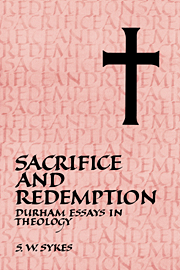Book contents
- Frontmatter
- Contents
- List of contributors
- Prefatory note
- Introduction
- PART I
- PART II
- PART III
- 11 The conscious and the unconscious sacrifice: Kierkegaard on art, suffering and religion
- 12 Pearse's sacrifice: Christ and Cuchulain crucified and risen in the Easter Rising, 1916
- 13 The concept of sacrifice in Anglican social ethics
- 14 Eucharistic sacrifice: the problem of how to use a liturgical metaphor, with special reference to Simone Weil
- PART IV
- Index of biblical and ancient references
- Index of persons
11 - The conscious and the unconscious sacrifice: Kierkegaard on art, suffering and religion
Published online by Cambridge University Press: 10 March 2010
- Frontmatter
- Contents
- List of contributors
- Prefatory note
- Introduction
- PART I
- PART II
- PART III
- 11 The conscious and the unconscious sacrifice: Kierkegaard on art, suffering and religion
- 12 Pearse's sacrifice: Christ and Cuchulain crucified and risen in the Easter Rising, 1916
- 13 The concept of sacrifice in Anglican social ethics
- 14 Eucharistic sacrifice: the problem of how to use a liturgical metaphor, with special reference to Simone Weil
- PART IV
- Index of biblical and ancient references
- Index of persons
Summary
‘When Christians are exposed to public insult, when they suffer and die for his sake, Christ takes on visible form in his Church.’ These words of Dietrich Bonhoeffer (i959, 273) reflect an approach to Christian life and witness which had all but disappeared from mainstream Protestantism by the late eighteenth century but which was then rediscovered in the wake of the Romantic movement. One of the main contributors to this rediscovery was Soren Kierkegaard (1813–55) whose late diaries and (simultaneous) polemics against the established Church return again and again to the question of what it means to be a witness to Christ. Kierkegaard's answer to this question was that a true witness did not testify by preaching from a well-endowed and socially respected pulpit but by suffering for and because of the gospel. A true witness is a blood-witness, a martyr in what Kierkegaard, rightly or wrongly, took to be the universal and undisputed sense of the early Church. Such witnesses are ‘the sacrificed ones’ (Kierkegaard 1967-78, vol.iv, 562).
No doubt there is much that is morbid in Kierkegaard's preoccupation, one might even say obsession, with the themes of martyrdom, sacrifice and freely chosen suffering; nor can it be disputed that there is something stifling in the intensity and repetitiveness with which he treats these matters; nor, finally, can it be denied that Kierkegaard himself would make a fascinating ‘case’ in the annals of the psychopathology of religious melancholy.
- Type
- Chapter
- Information
- Sacrifice and RedemptionDurham Essays in Theology, pp. 205 - 217Publisher: Cambridge University PressPrint publication year: 1991



